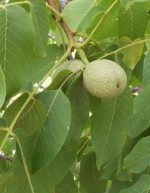 Also called the Persian walnut, this deciduous tree is native to the area from southeastern Europe to China. It was introduced to the Americas by the English colonists by the 1600s and now is cultivated in the United States with a commercially important presence in California especially in the Central Valley. English walnut belongs to the Juglandaceae plant family that also includes pecan and hickory. The tree grows up to 120′ tall (usually under 60′) and has broad crown and a short trunk. The bark is smooth and olive-brown when young but turns silvery-grey and develops scattered broad fissures with maturity. The alternate leaves are are 10-16″ long and are pinnately divided into 5-11 oblong leaflets that are 4-7″ long. Clusters of yellowish green male and female flowers appear in the late spring on the same tree. The male flowers are in drooping catkins 2-4″ long while the female flowers are in small terminal clusters of 2-5. The fruit ripens in the autumn and consists of a semi-fleshy green husk and a rough-surfaced brown nut containing a large edible seed. Although the nuts of the English walnut tree are economically important, the tree itself is a beautiful ornamental. The roots of the tree produce juglone, however, a chemical that inhibits the growth of many other plants. The fallen leaves are also toxic to other plants and should not be added to compost piles. English walnut is usually grafted onto black walnut rootstock to improve disease resistance. Many cultivars have been developed providing a variety of characteristics including thickness of shell, taste of meat, bearing time, and size of tree and nut. The genus name, Juglans, comes from the Latin jovis meaing of Jupiter and glans meaning acorn. The specific epithet, regia, is the Latin word meaning royal and refers to the very high quality of the nuts.
Also called the Persian walnut, this deciduous tree is native to the area from southeastern Europe to China. It was introduced to the Americas by the English colonists by the 1600s and now is cultivated in the United States with a commercially important presence in California especially in the Central Valley. English walnut belongs to the Juglandaceae plant family that also includes pecan and hickory. The tree grows up to 120′ tall (usually under 60′) and has broad crown and a short trunk. The bark is smooth and olive-brown when young but turns silvery-grey and develops scattered broad fissures with maturity. The alternate leaves are are 10-16″ long and are pinnately divided into 5-11 oblong leaflets that are 4-7″ long. Clusters of yellowish green male and female flowers appear in the late spring on the same tree. The male flowers are in drooping catkins 2-4″ long while the female flowers are in small terminal clusters of 2-5. The fruit ripens in the autumn and consists of a semi-fleshy green husk and a rough-surfaced brown nut containing a large edible seed. Although the nuts of the English walnut tree are economically important, the tree itself is a beautiful ornamental. The roots of the tree produce juglone, however, a chemical that inhibits the growth of many other plants. The fallen leaves are also toxic to other plants and should not be added to compost piles. English walnut is usually grafted onto black walnut rootstock to improve disease resistance. Many cultivars have been developed providing a variety of characteristics including thickness of shell, taste of meat, bearing time, and size of tree and nut. The genus name, Juglans, comes from the Latin jovis meaing of Jupiter and glans meaning acorn. The specific epithet, regia, is the Latin word meaning royal and refers to the very high quality of the nuts.
Type: Deciduous tree
Outstanding Characteristic: Nuts
Form: Wide spreading canopy
Size: 30-50’ H x 30’ W
Light: Full sun
Soil: Fertile, moist, well-drained. Will not tolerate prolonged drought. Soak tree for a half day two weeks before harvest.
Fertilizer: Fertilize once in the spring as buds form and again in the fall just before harvest with a complete fertilizer high in nitrogen such as 18-4-8. Since the roots of the tree extend l½ the size of the canopy be sure to spread the fertilizer through out the area and water in well.
Hardiness: Zones 5-9
Care: Prune older trees during winter dormancy to thin out crowded or crossing branches or to remove damaged or dead wood. Harvest after the green husks have fallen off the nuts, wash, and dry in trays in the sun.
Propagation: Stratified seed, grafting, budding, hardwood cutting or micro-propagation techniques
Pests and Diseases: Susceptible to crown rot water mold fungi, aphids, and walnut husk fly.
